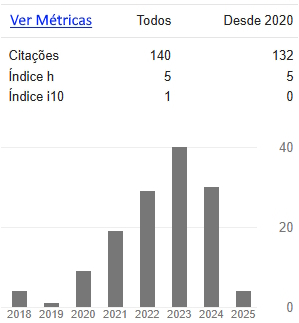[MOBILI] QUALI[DADE] URBANA: EIXO DE TRANSFORMAÇÃO URBANA EM GUAIANASES, SÃO PAULO-SP
Keywords:
eixo de estruturação, mobilidade, qualidade urbanaAbstract
There is in the city of São Paulo, since its urbanization in the 19th century, the railway as a structuring element that distinguishes two regions - east and west - under physical and social aspects. Between them, it is evident the unfavorable position of the East Zone in relation to the distance from the center, being the first region to be occupied by the popular, who crossed the territory through the railroad and the great road works of the city, which, since its formation, despised the space available for pedestrians. Today, 2020, in the far east is the district of Guaianases, occupied by the low-income population who, thirty kilometers away from the center, have the train as their main means of access to the east. In addition to the low employment and quality of transportation, the neighborhood has a high percentage of workers who spend more than one hour moving house-to-work; factors that characterize the place as a dormitory neighborhood. In this context, the Station Area appears, located in the axis of neighborhood structuring and which, responsible for configuring the daily displacements of the local population, is assumed as the starting point for the transformation of its space. Therefore, surveys were conducted around the Guaianases Station area which, through quantitative and qualitative analysis, made it possible to identify the temporal, physical, and social conditions of its space; in additon to the revision of the current pertinent legislation which, linked to the principles of sustainable transportation, make it possible to explore instruments and policies aimed at local development of the neighborhood and, later, the city.
Downloads
References
BEM, S. F. de. Contribuição para estudos das estações ferroviárias paulistas. 1998. Dissertação (Mestrado) – Faculdade de Arquitetura e Urbanismo, Universidade de São Paulo. São Paulo, 1998.
BRASIL. Constituição (1988). Constituição da República Federativa do Brasil. Brasília: Senado Federal, 1988. Disponível em: < http://www.planalto.gov.br/ccivil_03/Constituicao/Constituicao.htm#art183>. Acesso em: 14/03/2020.
_____. Constituição Federal (1988). Lei nº 10.257, de 10 de julho de 2001. Regulamenta os arts. 182 e 183 da Constituição Federal, estabelece diretrizes gerais da política urbana e dá outras providências. Disponível em: <http://www.planalto.gov.br/ccivil_03/leis/leis_2001/l10257.htm>. Acesso em: 14/03/2020.
FARQUHAR, M. Definitions of quality of life: a taxonomy. Journal of Advanced Nursing, Oxford, v.22, n.3, p.502-8, 1995. https://doi.org/10.1046/j.1365-2648.1995.22030502.x
FLECK, M.P.A.; LOUZADA, S.; XAVIER, M.; CHACHAMOVICH, E.; VIEIRA, G.; SANTOS, L.; PINZON, V. Aplicação da versão em português do instrumento de avaliação de qualidade de vida da Organização Mundial da Saúde. Revista de Saúde Pública, Rio de Janeiro, v.33, n.2, p.198-205, 1999.
INSTITUTO BRASILEIRO DE GEOGRAFIA E ESTATÍSTICA. COORDENAÇÃO DE POPULAÇÃO E INDICADORES SOCIAIS. Perfil dos municípios brasileiros: gestão pública 2005. Rio de Janeiro: IBGE, 2016. Disponível em: <https://biblioteca.ibge.gov.br/visualizacao/livros/liv32431.pdf>. Acesso em: 14/03/2020.
______________________________________________. Censo Demográfico (2000). Rio de Janeiro: IBGE, 2010. Disponível em: <https://biblioteca.ibge.gov.br/index.php/biblioteca-catalogo?view=detalhes&id=78>. Acesso em: 16/03/2020.
INSTITUTO BRASILEIRO DE AVALIAÇÕES E PERÍCIAS DE ENGENHARIA DE SÃO PAULO. Valores de Edificações de Imóveis Urbanos. IBAPE/SP, 2017. Disponível em: <https://www.ibape-sp.org.br/adm/upload/uploads/1543595741-VEIU%202017.pdf>. Acesso em: 16/03/2020.
INSTITUTO DE POLÍTICAS DE TRANSPORTE E DESENVOLVIMENTO. Guia de implementação de políticas e projetos de DOTS. Rio de Janeiro: ITDP Brasil, 2017. Disponível em: < http://itdpbrasil.org.br/wp-content/uploads/2017/12/ITDP-BR-DU-GUIADOTS-V2.3.pdf>. Acesso em: 10/11/19.
_____________________________________________________. Padrão de Qualidade DOTS. Rio de Janeiro: ITDP Brasil, 2017. Disponível em: . Acesso em: 10/11/19.
LANGENBUCH, J. R. A estruturação da grande São Paulo: estudo de geografia urbana. 1968. Tese (doutorado) - Faculdade de Filosofia, Ciências e Letras de Rio Claro, Universidade Estadual de Campinas. Rio Claro, SP, 1968.
MOURA, I. B., OLIVEIRA, G. T., FIGUEIREDO, A. C. Plano Diretor Estratégico de São Paulo (PDE-SP): análise das estratégias sob a perspectiva do desenvolvimento orientado ao transporte sustentável. In: BALBIM, R., KRAUSE, C., CLARISSE, C. L. (org). Cidade em movimento: mobilidades e interações no desenvolvimento urbano. Brasília: Ipea, ITDP, 2016. p. 143-180.
RAFAEL, H. M. P. et al. Desigualdades socioespaciais de acesso a oportunidades nas cidades brasileiras (2019). Texto para Discussão Ipea, 2535. Instituto de Pesquisa Econômica Aplicada – IPEA. Disponível em: <http://repositorio.ipea.gov.br/handle/11058/9586>. Acesso em: 14/03/2020.
RAMOS, S. C. S. Nosso Bairro, Nossa Vida. Memórias de Guaianases. São Paulo: Clube de Autores, 2017.
SÃO PAULO. Caderno de Propostas dos Planos Regionais das Subprefeituras. Quadro Analítico Guaianases. São Paulo: Secretaria Municipal de Desenvolvimento Urbano, 2016.
__________. Caderno de Propostas dos Planos Regionais das Subprefeituras. Quadro Analítico Macrorregional – Macrorregião Leste 2. São Paulo: Secretaria Municipal de Desenvolvimento Urbano, 2016.
__________. Pesquisa Origem Destino 2017. São Paulo: Secretaria Estadual dos Transportes Metropolitanos, 2019. Disponível em: <http://www.metro.sp.gov.br/pesquisa-od/arquivos/Ebook%20Pesquisa%20OD%202017_final_240719_versao_4.pdf>. Acesso em: 10/11/2019.
__________. Pesquisa de Emprego e Desemprego – PED. São Paulo: Ministério do Trabalho e Previdência Social, 2015. Disponível em: <https://www.seade.gov.br/produtos/midia/2017/01/MSP_Indicadores_25jan_2.pdf>. Acesso em: 10/11/2019.
__________. Plano Diretor Estratégico de São Paulo (2002). Lei nº 13.430, de 13 de setembro de 2002. Disponível em: https://leismunicipais.com.br/a/sp/s/sao-paulo/lei-ordinaria/2002/1343/13430/lei-ordinaria-n-13430-2002-plano-diretor-estrategico-revoga-a-lei-n-10676-88-e-dispositivos-das-leis-n-s-13-260-01-8-881-79-9-049-80-9-411-81. Acesso em: 14/03/2020.
__________. Plano Diretor Estratégico de São Paulo (2014). Lei nº 16.050, de 31 de julho de 2014. Disponível em: https://leismunicipais.com.br/a/sp/s/sao-paulo/lei-ordinaria/2014/1605/16050/lei-ordinaria-n-16050-2014-aprova-a-politica-de-desenvolvimento-urbano-e-o-plano-diretor-estrategico-do-municipio-de-sao-paulo-e-revoga-a-lei-n-13430-2002. Acesso em: 14/03/2020.
SEADE – FUNDAÇÃO SISTEMA ESTADUAL DE ANÁLISE DE DADOS. Índice Paulista de Vulnerabilidade Social. São Paulo: SEADE, 2010. Disponível em: <http://www.ipvs.seade.gov.br/view/index.php?selLoc=0&selTpLoc=2&prodCod=2>. Acesso em: 20/03/2020.
SIM, D.; GEHL, J. Soft City: Building Density for Everyday Life. Washington D.C.: Island Press, 2019.
VILLAÇA, F. Espaço intra-urbano no Brasil. 2ª. ed. São Paulo: Studio Nobel, 1998.
_________. As ilusões do plano diretor. 1ª. ed. São Paulo: [s.n.], 2005.

